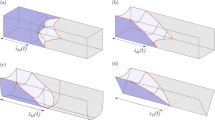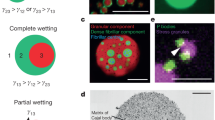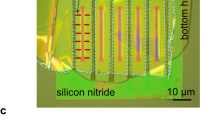Abstract
Capillary condensation of water is ubiquitous in nature and technology. It routinely occurs in granular and porous media, can strongly alter such properties as adhesion, lubrication, friction and corrosion, and is important in many processes used by microelectronics, pharmaceutical, food and other industries1,2,3,4. The century-old Kelvin equation5 is frequently used to describe condensation phenomena and has been shown to hold well for liquid menisci with diameters as small as several nanometres1,2,3,4,6,7,8,9,10,11,12,13,14. For even smaller capillaries that are involved in condensation under ambient humidity and so of particular practical interest, the Kelvin equation is expected to break down because the required confinement becomes comparable to the size of water molecules1,2,3,4,5,6,7,8,9,10,11,12,13,14,15,16,17,18,19,20,21,22. Here we use van der Waals assembly of two-dimensional crystals to create atomic-scale capillaries and study condensation within them. Our smallest capillaries are less than four ångströms in height and can accommodate just a monolayer of water. Surprisingly, even at this scale, we find that the macroscopic Kelvin equation using the characteristics of bulk water describes the condensation transition accurately in strongly hydrophilic (mica) capillaries and remains qualitatively valid for weakly hydrophilic (graphite) ones. We show that this agreement is fortuitous and can be attributed to elastic deformation of capillary walls23,24,25, which suppresses the giant oscillatory behaviour expected from the commensurability between the atomic-scale capillaries and water molecules20,21. Our work provides a basis for an improved understanding of capillary effects at the smallest scale possible, which is important in many realistic situations.
This is a preview of subscription content, access via your institution
Access options
Access Nature and 54 other Nature Portfolio journals
Get Nature+, our best-value online-access subscription
9,800 Yen / 30 days
cancel any time
Subscription info for Japanese customers
We have a dedicated website for our Japanese customers. Please go to natureasia.com to subscribe to this journal.
Buy this article
- Purchase on SpringerLink
- Instant access to full article PDF
Prices may be subject to local taxes which are calculated during checkout


Similar content being viewed by others
Data availability
All the mentioned data to support this study and its conclusions are available upon request from Q.Y.
References
Charlaix, E. & Ciccotti, M. Capillary Condensation in Confined Media (CRC 2010).
van Honschoten, J. W., Brunets, N. & Tas, N. R. Capillarity at the nanoscale. Chem. Soc. Rev. 39, 1096–1114 (2010).
Malijevský, A. & Jackson, G. A perspective on the interfacial properties of nanoscopic liquid drops. J. Phys. Condens. Matter 24, 464121 (2012).
Barsotti, E., Tan, S. P., Saraji, S., Piri, M. & Chen, J.-H. A review on capillary condensation in nanoporous media: implications for hydrocarbon recovery from tight reservoirs. Fuel 184, 344–361 (2016).
Thomson, W. On the equilibrium of vapour at a curved surface of liquid. Proc. R. Soc. Edinb. 7, 63–68 (1872).
Aukett, P. N., Quirke, N., Riddiford, S. & Tennison, S. R. Methane adsorption on microporous carbons—a comparison of experiment, theory, and simulation. Carbon 30, 913–924 (1992).
Fisher, L. R., Gamble, R. A. & Middlehurst, J. The Kelvin equation and the capillary condensation of water. Nature 290, 575–576 (1981).
Kohonen, M. M. & Christenson, H. K. Capillary condensation of water between rinsed mica surfaces. Langmuir 16, 7285–7288 (2000).
Mitropoulos, A. Ch. The Kelvin equation. J. Colloid Interface Sci. 317, 643–648 (2008).
Zhong, J. et al. Capillary condensation in 8 nm deep channels. J. Phys. Chem. Lett. 9, 497–503 (2018).
Yang, G., Chai, D., Fan, Z. & Li, X. Capillary condensation of single- and multicomponent fluids in nanopores. Ind. Eng. Chem. Res. 58, 19302–19315 (2019).
Kim, S., Kim, D., Kim, J., An, S. & Jhe, W. Direct evidence for curvature-dependent surface tension in capillary condensation: Kelvin equation at molecular scale. Phys. Rev. X 8, 041046 (2018).
Gruener, S., Hofmann, T., Wallacher, D., Kityk, A. V. & Huber, P. Capillary rise of water in hydrophilic nanopores. Phys. Rev. E 79, 067301 (2009).
Vincent, O., Marguet, B. & Stroock, A. D. Imbibition triggered by capillary condensation in nanopores. Langmuir 33, 1655–1661 (2017).
Shin, D., Hwang, J. & Jhe, W. Ice-VII-like molecular structure of ambient water nanomeniscus. Nat. Commun. 10, 286 (2019).
Verdaguer, A., Sacha, G. M., Bluhm, H. & Salmeron, M. Molecular structure of water at interfaces: wetting at the nanometer scale. Chem. Rev. 106, 1478–1510 (2006).
Matsuoka, H., Fukui, S. & Kato, T. Nanomeniscus forces in undersaturated vapors: observable limit of macroscopic characteristics. Langmuir 18, 6796–6801 (2002).
Powles, J. G. On the validity of the Kelvin equation. J. Phys. Math. Gen. 18, 1551–1560 (1985).
Walton, J. P. R. B. & Quirke, N. Capillary condensation: a molecular simulation study. Mol. Simul. 2, 361–391 (1989).
Cheng, S. & Robbins, M. O. Nanocapillary adhesion between parallel plates. Langmuir 32, 7788–7795 (2016).
Knežević, M. & Stark, H. Capillary condensation in an active bath. EPL 128, 40008 (2019).
Sing, K. S. W. & Williams, R. T. Historical aspects of capillarity and capillary condensation. Microporous Mesoporous Mater. 154, 16–18 (2012).
Schoen, M. & Günther, G. Phase transitions in nanoconfined fluids: synergistic coupling between soft and hard matter. Soft Matter 6, 5832–5838 (2010).
Gor, G. Y., Huber, P. & Bernstein, N. Adsorption-induced deformation of nanoporous materials—a review. Appl. Phys. Rev. 4, 011303 (2017).
Altabet, Y. E., Haji-Akbari, A. & Debenedetti, P. G. Effect of material flexibility on the thermodynamics and kinetics of hydrophobically induced evaporation of water. Proc. Natl Acad. Sci. USA 114, E2548–E2555 (2017).
Radha, B. et al. Molecular transport through capillaries made with atomic scale precision. Nature 538, 222–225 (2016).
Gopinadhan, K. et al. Complete steric exclusion of ions and proton transport through confined monolayer water. Science 363, 145–148 (2019).
Drelich, J., Chibowski, E., Meng, D. D. & Terpilowski, K. Hydrophilic and superhydrophilic surfaces and materials. Soft Matter 7, 9804–9828 (2011).
Mücksch, C., Rösch, C., Müller-Renno, C., Ziegler, C. & Urbassek, H. M. Consequences of hydrocarbon contamination for wettability and protein adsorption on graphite surfaces. J. Phys. Chem. C 119, 12496–12501 (2015).
Fumagalli, L. et al. Anomalously low dielectric constant of confined water. Science 360, 1339–1342 (2018).
Weeks, B. L. & Vaughn, M. W. Direct imaging of meniscus formation in atomic force microscopy using environmental scanning electron microscopy. Langmuir 21, 8096–8098 (2005).
Malijevský, A. & Parry, A. O. Modified Kelvin equations for capillary condensation in narrow and wide grooves. Phys. Rev. Lett. 120, 135701 (2018).
Christenson, H. K. & Thomson, N. H. The nature of the air-cleaved mica surface. Surf. Sci. Rep. 71, 367–390 (2016).
Neek-Amal, M., Peeters, F. M., Grigorieva, I. V. & Geim, A. K. Commensurability effects in viscosity of nanoconfined water. ACS Nano 10, 3685–3692 (2016).
Horcas, I. et al. WSXM: a software for scanning probe microscopy and a tool for nanotechnology. Rev. Sci. Instrum. 78, 013705 (2007).
Gor, G. Y. et al. Elastic response of mesoporous silicon to capillary pressures in the pores. Appl. Phys. Lett. 106, 261901 (2015).
Bangham, D. H. & Fakhoury, N. The expansion of charcoal accompanying sorption of gases and vapours. Nature 122, 681–682 (1928).
Li, T. & Zhang, Z. Substrate-regulated morphology of graphene. J. Phys. D 43, 075303 (2010).
Scharfenberg, S., Mansukhani, N., Chialvo, C., Weaver, R. L. & Mason, N. Observation of a snap-through instability in graphene. Appl. Phys. Lett. 100, 021910 (2012).
Israelachvili, J. N. Intermolecular and Surface Forces (Academic, 2011).
Hibbeler, R. C. Mechanics of Materials 814 (Pearson, 2015).
McNeil, L. E. & Grimsditch, M. Elastic moduli of muscovite mica. J. Phys. Condens. Matter 5, 1681–1690 (1993).
Cost, J. R., Janowski, K. R. & Rossi, R. C. Elastic properties of isotropic graphite. Phil. Mag. 17, 851–854 (1968).
Ling, F. F., Lai, W. M. & Lucca, D. A. Fundamentals of Surface Mechanics: With Applications 96–97 (Springer, 2012).
Plimpton, S. Fast parallel algorithms for short-range molecular dynamics. J. Comput. Phys. 117, 1–19 (1995).
Berendsen, H. J. C., Grigera, J. R. & Straatsma, T. P. The missing term in effective pair potentials. J. Phys. Chem. 91, 6269–6271 (1987).
Wu, Y. & Aluru, N. R. Graphitic carbon–water nonbonded interaction parameters. J. Phys. Chem. B 117, 8802–8813 (2013).
Cicero, G., Grossman, J. C., Schwegler, E., Gygi, F. & Galli, G. Water confined in nanotubes and between graphene sheets: a first principle study. J. Am. Chem. Soc. 130, 1871–1878 (2008).
Sendner, C., Horinek, D., Bocquet, L. & Netz, R. R. Interfacial water at hydrophobic and hydrophilic surfaces: slip, viscosity, and diffusion. Langmuir 25, 10768–10781 (2009).
Acknowledgements
This work was funded by Lloyd’s Register Foundation, the European Research Council, Graphene Flagship and the Royal Society. Q.Y. acknowledges support from the Leverhulme Early Career Fellowship, and F.C.W. from the Strategic Priority Research Program of the Chinese Academy of Sciences (XDB22040402) and the CAS Youth Innovation Promotion Association.
Author information
Authors and Affiliations
Contributions
A.K.G. suggested the project and directed it together with Q.Y. Q.Y. and P.Z.S. fabricated devices. Q.Y. performed measurements and carried out data analysis with help from L.F., Y.V.S., S.J.H. and Z.W.Z. F.C.W. provided theoretical support. A.K.G., Q.Y., F.C.W. and I.V.G. wrote the manuscript. All authors contributed to discussions.
Corresponding authors
Ethics declarations
Competing interests
The authors declare no competing interests.
Additional information
Peer review information Nature thanks Patrick Huber and the other, anonymous, reviewer(s) for their contribution to the peer review of this work.
Publisher’s note Springer Nature remains neutral with regard to jurisdictional claims in published maps and institutional affiliations.
Extended data figures and tables
Extended Data Fig. 1 Nanofabrication of 2D channels.
a, Simplified flow chart for our fabrication procedures. (1) Graphene spacers and the bottom crystal of either mica or graphite (shown in yellow) were assembled on top of an oxidized Si wafer. (2) A suspended SiN membrane with a rectangular hole was prepared separately. (3) The two-layer assembly was transferred from the Si oxide wafer onto the SiN membrane. The opening was extended through the assembly by RIE. (4) The top crystal of mica or graphite was placed on top of graphene spacers. b, AFM micrograph of graphene spacers with N = 5. The colour scale is given by the height profile (blue curve). c, Optical image of a final mica device used in our experiments. The bottom mica crystal shows up in purple on top of the square SiN membrane. Graphene spacers (N = 3) and the top mica layer are outlined in blue and yellow, respectively. d, Cross-sectional scanning transmission electron microscopy image of a graphite channel with N = 2. The blue ticks mark the channel’s edges.
Extended Data Fig. 2 Measurements of capillary condensation.
a, Our AFM set-up. Humidified nitrogen gas flows through the bottom chamber made from an aluminium alloy. A silicon wafer of 15 × 15 mm2 in size is seen to cover the chamber, flush with its top surface. The white rubber gasket was lowered during AFM measurements to seal the space above the Si wafer. Inset, cross-sectional schematic showing how capillary devices were mounted during AFM measurements. b, Schematic of a water plug inside our capillaries. For brevity, the layered structure of water is ignored in this sketch. When the top chamber is at low RH, the meniscus slightly retracts inside the capillary to create a vapour pressure gradient. The RH gradient stabilizes two menisci with the same curvature at both exit and entrance. The distance from the exit meniscus to the opening is expected to be short because, in our atomically flat capillaries, water moves much faster as liquid than vapour26.
Extended Data Fig. 3 Visualization of the condensation transition using AFM.
a–c, Images of a graphite capillary with N = 3 at RH of 55%, 70% and 95% (a, b and c, respectively). The upper part of each image shows sagging of the top graphite crystal (H ≈ 80 nm) into the 2D channel. The lower part shows the area immediately outside the channel, which is not covered by the top graphite. The black dotted lines mark a border between the two regions (edge of the top crystal). The colour scales for the lower and upper parts of the AFM images are given by the green and black curves, respectively. The profiles are averaged over ∼100 nm along the y direction, and the curves in the upper parts of all the panels are provided on the same scale given by the black arrows in panel a. A small number of horizontal scanning lines (x direction) around the black-dot dividing lines were removed for clarity because they contained numerous instabilities caused by the AFM tip moving along the edge of the top crystal and jumping up and down. Such instabilities are typical for AFM scanning close to edges.
Extended Data Fig. 4 Non-hysteretic capillary condensation with slow dynamics.
a, Sagging profiles for a graphite capillary (N = 4) with increasing and decreasing RH between 75% and 80%. Black curve, initial dry-state profile. Red curve, RH was increased to 80%. Then, RH was returned to 75% and maintained at this humidity. AFM profiles were taken after 4 h, 9 h and 16 h (colour coded). b, The N = 6 graphite capillary was brought from the dry state (black curve) into the state filled with water and kept for an hour at 95% RH (red). The humidity was then decreased to ∼30%, well below the condensation transition observed at 62.5 ± 2.5% for this device. The colour-coded curves show the time evolution towards the original dry state. Note that the sagging depths δ for such hysteretic loops were highly reproducible but details of sagging profiles could differ in different RH cycles. For example, the top crystal’s adhesion to the right wall was different in the original and final dry states, as seen in a (compare black and purple curves). This hysteresis is attributed to irreproducible vdW attachments of top crystals to channel sidewalls.
Extended Data Fig. 5 Capillary condensation in 2D channels with different initial sagging.
a, b, Sagging profiles for two N = 5 graphite capillaries with different δ0. RH was increased in 5% steps (colour coded). The water condensation transition occurred between 80% and 85% RH in a and between 70% and 75% in b. The difference in RHC for the same N is attributed to different h in the two cases.
Extended Data Fig. 6 Remnant sagging above the condensation transition.
a, Schematic of top crystal sagging. b, Typical behaviour observed for the sagging depth δ as a function of RH, after the condensation transition occurred at RH < 60%. Symbols: Measurements for two different mica capillaries with N = 8. The solid curves are best fits using equations (3) and (4) (colour-coded). The grey symbol with error bars indicates the experimental accuracy.
Extended Data Fig. 7 MD simulations of strongly confined water.
a, Its density profiles at different distances h between two rigid capillary walls with the contact angle θ ≈ 11°. b, Same calculations but for contact angle 85°. The orange dashed lines mark positions of the surfaces that defined the 2D channels. Water exhibits a pronounced layered structure near each surface, and the structures start to overlap for h < 15 Å. Top insets, cross-sectional profiles for water droplets placed on the surfaces with the given θ.
Extended Data Fig. 8 Changes in the solid–liquid surface energy caused by atomic-scale confinement.
Calculated Δγ(h) for several characteristic θ. The arrows indicate the number of molecular layers of water that fit inside the 2D channels.
Rights and permissions
About this article
Cite this article
Yang, Q., Sun, P.Z., Fumagalli, L. et al. Capillary condensation under atomic-scale confinement. Nature 588, 250–253 (2020). https://doi.org/10.1038/s41586-020-2978-1
Received:
Accepted:
Published:
Issue Date:
DOI: https://doi.org/10.1038/s41586-020-2978-1



